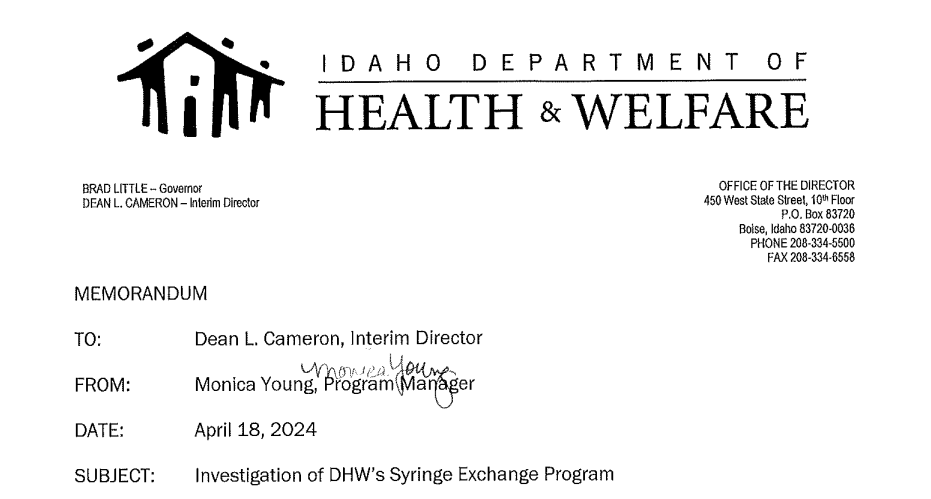
Idaho investigation: Before police raided syringe program subgrantee, state reimbursed illegal harm reduction tools
Listen
(Runtime 0:59)
Read
An internal investigation by the Idaho Department of Health and Welfare shows state funds likely were used to reimburse for the purchase of harm reduction materials illegal in the state of Idaho.
The finding came after the raid of two Idaho Harm Reduction Project (IHRP) offices in southern Idaho in February for alleged drug paraphernalia distribution.
At the time, IHRP was a subgrant recipient of the state’s syringe exchange program that operated a safe syringe program that said it was able to “provide capacity-building for other SSPs” through a low-barrier buprenorphine clinic.
The Idaho Legislature repealed the Syringe and Needle Exchange Act in response to the raids.
Harm reduction is a term used to describe a range of tools that are used to lessen the immediate negative impacts of drug use, such as overdose deaths and the spread of blood-borne disease, while connecting people with substance use disorder to resources and education.
Harm reduction includes materials that allow people to use drugs more safely, such as syringe exchange programs, access to the opioid reversal drug Naloxone, and drug testing strips that allow users to check if a substance they plan to use is laced with fentanyl.
Monica Young, a human resource manager at Idaho Health and Welfare, conducted the report. Young wrote that, at the Intermountain West Harm Reduction Conference in September, IHRP acknowledged during a recorded panel that harm reduction materials they distributed were illegal.
Young also spoke with five other safe syringe subgrantees.
“These organizations spoke of their partnership with other organizations in their communities and with law enforcement,” she wrote. “They indicated they did not share the same disdain for law enforcement that was demonstrated by IHRP employees. Moreover, the SSPs emphasized that they believed their operations had been operating legally.”
In her report, Young noted the Syringe and Needle Exchange Act specifies an entity “may procure supplies needed to operate a syringe and needle exchange program” but did not define approved “supplies.”
She also noted “a distinct disconnect between (the Division of Public Health, a part of Idaho Health and Welfare) leadership and DPH program staff operating the syringe and needle exchange program.”
Young also described an “unprecedented” level of independence and decision-making by safe syringe program staff, which she attributed to DPH leadership, focusing on the statewide pandemic response rather than operational details for the syringe program, which was implemented after the passage of the Syringe and Needle Exchange Act in 2019.
According to Young’s report, staff running the syringe program understood the Act’s purpose of preventing disease transmission and overdose deaths as indications that other evidence-based harm reduction tools, such as fentanyl test strips and injection alternatives, were appropriate.
The Legislature moved to legalize fentanyl test strips this spring after previously classifying them as drug paraphernalia. The new law will go into effect July 1.
Meanwhile, Division of Public Health leadership interpreted the Act narrowly as a strict syringe/needle exchange.
Young wrote that the disconnect led to SSP staff encouraging the use of, and in some cases reimbursing the purchase of, harm reduction materials, such as fentanyl test strips, injection alternatives materials, including pipes and instruction cards, and “cookers,” which containers used to mix and heat powdered and solid drugs for injection.
Young also found that on one occasion Division of Public Health staff purchased cookers directly, and paid for printing of documents, such as “how to test for fentanyl” via the Department of Health and Welfare’s contract with a local printer.
According to the Centers for Disease Control and Prevention, cookers often are distributed alongside syringes at safe syringe programs to prevent blood-borne disease transmission.
Injection alternatives are considered harm reduction because they reduce the spread of disease through intravenous drugs, reduce harm to veins and increase opportunities to connect users with treatment resources.
In several cases, the report noted that syringe exchange program staff members were aware that some safe syringe programs, including the Idaho Harm Reduction Project, offered various other harm reduction tools but left it to individual programs’ discretion.
According to Young’s report, “Until it was pointed out to them, DPH program staff did not see how their communications could imply support for purchasing and being reimbursed” for various unapproved harm reduction tools.
Meanwhile, DPH leadership was unaware of cookers, test strips, injection alternatives, and other resources being used by the programs or reimbursed by DPH.
Young’s recommendations included determining what supplies are considered allowable within the Act and also what funding may be used to purchase or reimburse items.
Though the Act was repealed this year, some lawmakers said they plan to bring the syringe exchange back with amendments to avoid similar issues in the future.
The report also recommended DPH leadership review its document approval policy and matrix to determine if clarification, changes and staff training are warranted and provide additional training as needed for employees.
It further recommended working to ensure appropriate practices for “in-kind” services, such as printing and implementing training to establish maintaining boundaries between staff and clients.















